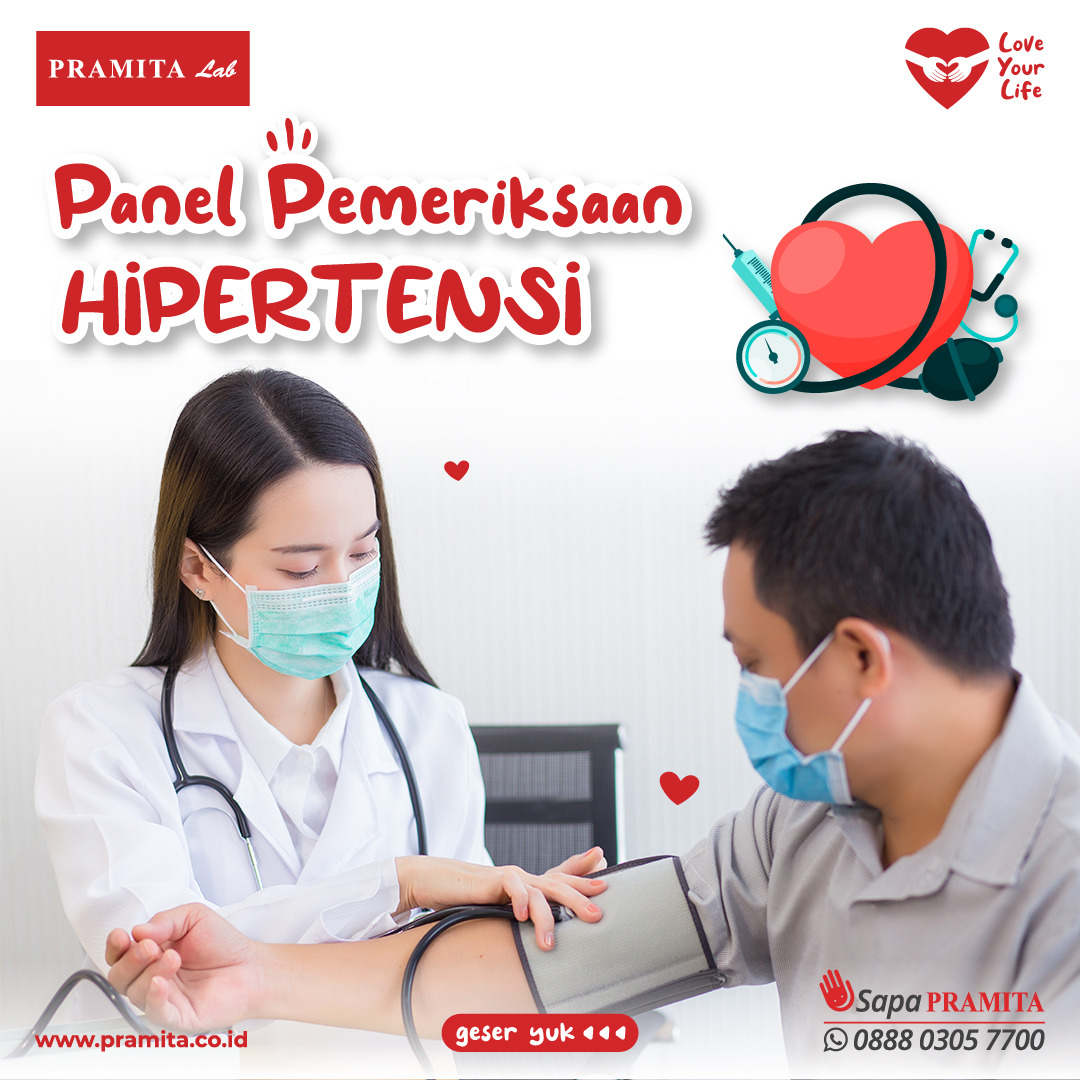Healthy Inspirations
Semua
Work Life
INFO PEMERIKSAAN
Parenting/Kesehatan Anak
LabPedia
Life Style
Kesehatan Wanita
Health Info
Millenial
Info Kesehatan
Mitos/Fakta

HYPERTENSION EXAMINATION PANEL
Mon, 19 Dec 2022
The way to find out if you have hypertension is to take an accurate blood pressure measurement at the clinic or use blood pressure measurements outside the clinic to detect white coat hypertension and hidden hypertension. White coat hypertension is blood pressure that is elevated in the clinic but normal when measured outside the clinic. Covert hypertension is blood pressure that is normal when measuring blood pressure in the clinic but increases when measuring outside the clinic.
The definition of hypertension is:
- Systolic Blood Pressure (TDS) ≥140 mmHg and or - Diastolic Blood Pressure (TDD) ≥ 90 mmHg.
Check blood pressure outside the clinic, if facilities are available, with Ambulatory Blood Pressure Monitoring (ABPM) or with Home Blood Pressure Monitoring (HBPM).
The difference between ABPM and HBPM are:
1. ABPM (Ambulatory Blood Pressure Monitoring) is a method of measuring blood pressure for 24 hours including during sleep.
2. HBPM (Home Blood Pressure Monitoring) is blood pressure measurement that is done alone at home or in other places outside the clinic. Measurements are taken using an oscillometer, carried out in a sitting position, with feet flat on the floor, back against a chair or wall and arms placed on a flat surface (table, at the level of the heart). Blood pressure checked in the morning and evening. Morning measurements were taken 1 hour after waking up, after urinating, had not had breakfast but had taken medicine. At night, blood pressure measurements are taken before going to bed. Measurements are carried out at least 2 times for each examination with an interval of 1 minute. The final result is the average of at least 2 times of examination within 3 days or more (recommended 7 days) by differentiating the results of morning and evening measurements.
Hypertension, especially at very high blood pressure, can cause target organ damage, for example hypertensive retinopathy, left ventricular hypertrophy or kidney damage, so additional tests are needed to look at risk factors or co-morbidities such as:
• ECGs
• Echocardiography
• carotid ultrasound
• abdominal ultrasound
• Fat profile
• Fasting blood sugar, 2 Hours PP, HbA1c
• Microalbuminuria.
Screening and detection of hypertension for everyone over the age of 18. At the age of more than 50 years, screening is increased as the incidence of hypertension increases at that age. For HPBM checks, it is recommended to use an internationally validated oscillometer and calibrate once every 6-12 months.
Author : dr. Dian Rahma Dewi, Consultant Doctor for PRAMITA Clinical Laboratory Jl. Aditywarman No. 73-75, Surabaya
The definition of hypertension is:
- Systolic Blood Pressure (TDS) ≥140 mmHg and or - Diastolic Blood Pressure (TDD) ≥ 90 mmHg.
Check blood pressure outside the clinic, if facilities are available, with Ambulatory Blood Pressure Monitoring (ABPM) or with Home Blood Pressure Monitoring (HBPM).
The difference between ABPM and HBPM are:
1. ABPM (Ambulatory Blood Pressure Monitoring) is a method of measuring blood pressure for 24 hours including during sleep.
2. HBPM (Home Blood Pressure Monitoring) is blood pressure measurement that is done alone at home or in other places outside the clinic. Measurements are taken using an oscillometer, carried out in a sitting position, with feet flat on the floor, back against a chair or wall and arms placed on a flat surface (table, at the level of the heart). Blood pressure checked in the morning and evening. Morning measurements were taken 1 hour after waking up, after urinating, had not had breakfast but had taken medicine. At night, blood pressure measurements are taken before going to bed. Measurements are carried out at least 2 times for each examination with an interval of 1 minute. The final result is the average of at least 2 times of examination within 3 days or more (recommended 7 days) by differentiating the results of morning and evening measurements.
Hypertension, especially at very high blood pressure, can cause target organ damage, for example hypertensive retinopathy, left ventricular hypertrophy or kidney damage, so additional tests are needed to look at risk factors or co-morbidities such as:
• ECGs
• Echocardiography
• carotid ultrasound
• abdominal ultrasound
• Fat profile
• Fasting blood sugar, 2 Hours PP, HbA1c
• Microalbuminuria.
Screening and detection of hypertension for everyone over the age of 18. At the age of more than 50 years, screening is increased as the incidence of hypertension increases at that age. For HPBM checks, it is recommended to use an internationally validated oscillometer and calibrate once every 6-12 months.
Author : dr. Dian Rahma Dewi, Consultant Doctor for PRAMITA Clinical Laboratory Jl. Aditywarman No. 73-75, Surabaya

